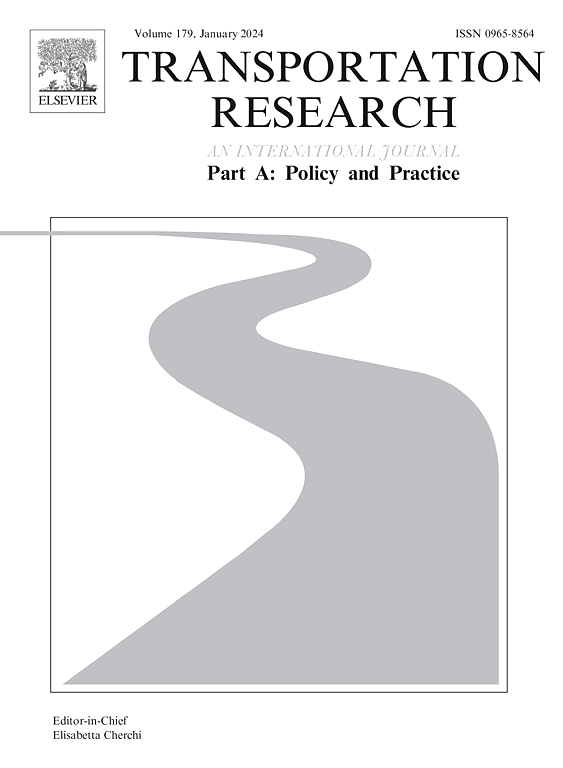空间布局对电动滑板车交通流的影响
IF 6.3
1区 工程技术
Q1 ECONOMICS
Transportation Research Part A-Policy and Practice
Pub Date : 2025-05-29
DOI:10.1016/j.tra.2025.104529
引用次数: 0
摘要
自然运动理论认为,空间的结构是运动模式的主要决定因素。然而,该领域的现有研究往往依赖于人工计数,无法捕捉到运动的时间变化,并且缺乏跨地点可转移性的证据。这项研究通过利用被动生成的GPS数据来解决这些局限性,这些数据是由全球增长的电动滑板车模式产生的。我们使用2021年三个月内在三个地区(索尔福德(英国)、罗奇代尔(英国)和曼海姆/路德维希港(德国))进行的约80,000次出行的GPS数据来模拟电动滑板车的交通流量。时空交叉验证的空间滞后模型表明,基于空间构型的参数具有较高的预测能力,而额外的吸引子参数对模型性能的影响最小。我们的研究结果为基础设施规划和政策干预提供了可行的见解,特别是对电动滑板车计划的有效规划、运营和管理。此外,研究结果强调,基于空间配置的建模方法可以在时间维度上得到增强,在交通规划中具有广泛的应用潜力。本文章由计算机程序翻译,如有差异,请以英文原文为准。
The influence of spatial configuration on e-scooter traffic flows
The theory of natural movement posits that the configuration of space is the primary determinant of movement patterns. Existing research in this domain, however, often relies on manual counting, fails to capture temporal variations in movement, and lacks evidence of transferability across locations. This study addresses these limitations by leveraging passively generated GPS data produced by the globally growing mode of e-scooters.
We model e-scooter traffic flows using GPS data of ∼80,000 trips over three months in 2021 in three areas: Salford (United Kingdom), Rochdale (United Kingdom), and Mannheim/Ludwigshafen (Germany). Spatio-temporally cross-validated spatial lag models demonstrate the high predictive power of spatial configuration-based parameters, while additional attractor parameters contribute minimally to model performance.
Our findings provide actionable insights for infrastructure planning and policy interventions, particularly for the effective planning, operation, and management of e-scooter schemes. Moreover, the results highlight that spatial configuration-based modelling methodology can be augmented with a temporal dimension, with broad potential application in transport planning.
求助全文
通过发布文献求助,成功后即可免费获取论文全文。
去求助
来源期刊
CiteScore
13.20
自引率
7.80%
发文量
257
审稿时长
9.8 months
期刊介绍:
Transportation Research: Part A contains papers of general interest in all passenger and freight transportation modes: policy analysis, formulation and evaluation; planning; interaction with the political, socioeconomic and physical environment; design, management and evaluation of transportation systems. Topics are approached from any discipline or perspective: economics, engineering, sociology, psychology, etc. Case studies, survey and expository papers are included, as are articles which contribute to unification of the field, or to an understanding of the comparative aspects of different systems. Papers which assess the scope for technological innovation within a social or political framework are also published. The journal is international, and places equal emphasis on the problems of industrialized and non-industrialized regions.
Part A''s aims and scope are complementary to Transportation Research Part B: Methodological, Part C: Emerging Technologies and Part D: Transport and Environment. Part E: Logistics and Transportation Review. Part F: Traffic Psychology and Behaviour. The complete set forms the most cohesive and comprehensive reference of current research in transportation science.

 求助内容:
求助内容: 应助结果提醒方式:
应助结果提醒方式:


